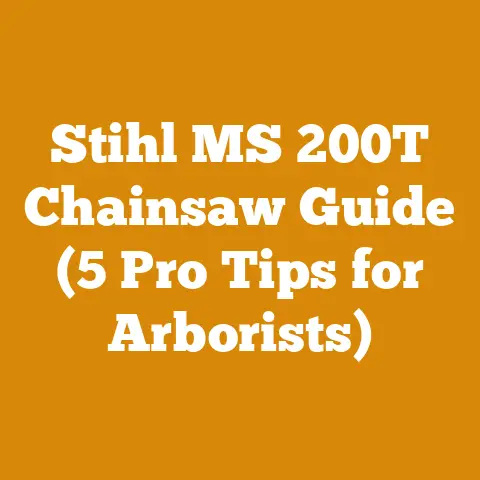Troy Bilt Horse Engine Replacement Tips (7 Must-Know Hacks)
Innovation in wood processing and firewood preparation has come a long way.
What was once the domain of brute strength and simple tools has evolved into a field incorporating advanced machinery, precision techniques, and a deep understanding of wood science.
As someone who’s spent decades immersed in the world of chainsaws, logging tools, and firewood, I’ve witnessed firsthand how these innovations have transformed the industry, making it safer, more efficient, and more sustainable.
One area where innovation is particularly evident is in engine technology.
The Troy-Bilt Horse tiller, a workhorse for many gardeners and small-scale farmers, relies on a robust engine to power its tines.
When that engine starts to falter, replacing it isn’t just about slapping in a new motor; it’s about understanding the nuances of the machine, the engine options available, and the specific challenges you might encounter.
That’s where these “7 Must-Know Hacks” come in.
They’re not just tricks; they’re insights gleaned from years of experience, designed to help you navigate the engine replacement process smoothly and efficiently.
Replacing the engine on a Troy-Bilt Horse tiller might seem daunting, but with the right knowledge and approach, it’s a manageable task.
Let’s dive in and explore these hacks to ensure your tiller is back in action, tilling your garden with renewed vigor.
Troy-Bilt Horse Engine Replacement Tips (7 Must-Know Hacks)
1. Understanding Your Existing Engine and Replacement Options
Before you even think about wrenches and sockets, the first crucial step is to thoroughly understand your existing engine.
This isn’t just about knowing the brand and model; it’s about understanding its specifications and how they relate to potential replacement engines.
- Identifying the Engine: The most common engines found on older Troy-Bilt Horse tillers are Briggs & Stratton or Tecumseh.
Newer models might feature Honda or other brands.
Locate the engine model number and specification number.
These are usually stamped on a metal plate or sticker affixed to the engine block, often near the starter or carburetor.
This information is your key to finding a compatible replacement. - Horsepower and Torque: Note the horsepower (HP) and torque ratings of your current engine.
These figures directly impact the tiller’s performance.
Replacing with an engine of significantly lower HP will result in reduced tilling power, while an engine with significantly higher HP might strain the tiller’s transmission.
Aim for a replacement engine with similar or slightly higher HP and torque. - Shaft Size and Configuration: This is where many people stumble.
The engine’s output shaft – the part that connects to the tiller’s transmission – must match the dimensions of your existing engine.
Measure the diameter and length of the shaft, and note its configuration (e.g., keyed, threaded).
This is a critical measurement for compatibility. - Engine Mounting Pattern: The mounting pattern refers to the bolt holes on the engine block that secure it to the tiller’s frame.
Measure the distance between these bolt holes.
The replacement engine must have a matching mounting pattern. Replacement Engine Options: Once you have all the necessary information about your existing engine, you can start exploring replacement options.
Consider these factors:- New vs.
Used: New engines offer the advantage of a warranty and guaranteed performance.
Used engines are often more affordable but may require repairs or have a shorter lifespan. - Brand Compatibility: While replacing with the same brand is often the simplest option, it’s not always necessary.
Many universal engines are designed to fit a variety of applications. - Engine Type: Consider whether you want to stick with a traditional gasoline engine or explore alternative options like propane or electric engines (although electric conversions are less common for tillers due to power requirements).
- My Experience: I once helped a friend replace the engine on his vintage Troy-Bilt Horse.
He was tempted to go with a cheaper, lower-HP engine, but I convinced him to stick with a comparable model.
The difference in tilling performance was night and day.
The original engine had the power to chew through compacted soil, while the lower-HP engine struggled.
- New vs.
2. Essential Tools and Safety Gear
Before you start wrenching, make sure you have the right tools and safety gear.
This isn’t just about convenience; it’s about ensuring a safe and efficient engine replacement.
- Cleaning the Mounting Surface: Clean the tiller’s frame where the engine will be mounted.
Remove any dirt, rust, or debris.
A wire brush or scraper can be helpful. - Checking the Mounting Holes: Inspect the engine mounting holes on the tiller’s frame.
Make sure they are clean and free of corrosion.
If the threads are damaged, use a thread chaser to repair them. - Greasing the Shaft: Apply a thin layer of grease to the engine’s output shaft.
This will help prevent corrosion and ensure smooth operation. - Inspecting the Drive Belt or Chain: If your tiller uses a drive belt or chain to transmit power from the engine to the transmission, inspect it for wear or damage.
Replace it if necessary. - Checking the Pulleys or Sprockets: Inspect the pulleys or sprockets that the drive belt or chain runs on.
Make sure they are clean and free of damage. - My Experience: I once neglected to clean the mounting surface before installing a new engine.
As a result, the engine didn’t sit flush against the frame, causing vibrations and premature wear.
5. Installing the New Engine: Precision is Key
Installing the new engine requires precision and attention to detail.
Take your time and double-check your work to ensure a proper fit and reliable operation.
- Positioning the Engine: Carefully position the new engine on the tiller’s frame, aligning the mounting holes.
- Securing the Engine: Install the engine mounting bolts and tighten them to the manufacturer’s specifications.
Use a torque wrench to ensure proper tightening. - Connecting the Fuel Line: Connect the fuel line to the carburetor.
Make sure the connection is secure and leak-free.
Use new fuel line clamps if necessary. - Connecting the Wiring: Connect all wiring to the engine, following the wiring diagram or the photos you took during the removal process.
Make sure all connections are secure and properly insulated. - Connecting the Throttle and Choke Linkages: Connect the throttle and choke linkages to the carburetor, referring to the photos you took during the removal process.
Adjust the linkages as needed to ensure proper operation. - Adding Oil: Add oil to the engine, following the manufacturer’s recommendations.
Use the correct type and viscosity of oil. - Adding Fuel: Add fuel to the fuel tank. Use fresh, high-quality gasoline.
- My Experience: I once accidentally reversed the throttle and choke linkages.
As a result, the engine ran at full throttle when it should have been idling, and vice versa.
This highlights the importance of careful reassembly and double-checking your work.
6. The First Start: A Moment of Truth
The first start is a moment of truth.
It’s when you find out if all your hard work has paid off.
- Priming the Carburetor: Prime the carburetor by pressing the primer bulb several times.
This will help draw fuel into the carburetor. - Setting the Choke: Set the choke to the “on” position.
This will enrich the fuel mixture and help the engine start more easily. - Starting the Engine: Turn the ignition key or pull the starter rope to start the engine.
- Adjusting the Choke: Once the engine starts, gradually open the choke until the engine runs smoothly.
- Checking for Leaks: Check for fuel and oil leaks.
If you find any leaks, tighten the connections or replace the faulty parts. - Adjusting the Idle Speed: Adjust the idle speed to the manufacturer’s specifications.
This will ensure that the engine idles smoothly without stalling. - Testing the Throttle Response: Test the throttle response by gradually increasing and decreasing the engine speed.
The engine should respond smoothly and without hesitation. - My Experience: I once spent hours troubleshooting an engine that wouldn’t start.
After checking everything, I finally discovered that the spark plug wire was loose.
This simple fix made all the difference.
7. Fine-Tuning and Maintenance: Keeping Your Tiller Running Smoothly
Once the engine is running, it’s essential to fine-tune it and perform regular maintenance to ensure optimal performance and longevity.
- Adjusting the Carburetor: Adjust the carburetor to optimize the engine’s fuel-air mixture.
This will improve fuel efficiency and reduce emissions. - Checking the Spark Plug: Check the spark plug for wear or damage.
Replace it if necessary. - Changing the Oil: Change the oil regularly, following the manufacturer’s recommendations.
This will help keep the engine clean and lubricated. - Cleaning the Air Filter: Clean the air filter regularly.
A dirty air filter can restrict airflow and reduce engine performance. - Sharpening the Tines: Sharpen the tiller’s tines regularly to maintain optimal tilling performance.
- Lubricating Moving Parts: Lubricate all moving parts, such as the throttle and choke linkages, to prevent corrosion and ensure smooth operation.
- Storing the Tiller: When storing the tiller for extended periods, drain the fuel tank and carburetor to prevent fuel degradation.
Cover the tiller to protect it from the elements. - My Experience: I once neglected to sharpen the tiller’s tines for several seasons.
As a result, the tilling performance was significantly reduced.
Sharpening the tines made a world of difference.
Key Concepts Explained
Let’s clarify some key concepts that are crucial for understanding engine replacement and wood processing in general:
- Green Wood vs.
Seasoned Wood: Green wood is freshly cut wood with a high moisture content.
Seasoned wood has been dried, reducing its moisture content.
Seasoned wood is ideal for firewood because it burns more efficiently and produces less smoke. - Horsepower vs.
Torque: Horsepower is a measure of the rate at which work can be done.
Torque is a measure of the twisting force.
In the context of a tiller, horsepower determines how quickly it can till, while torque determines how much force it can exert. - Carburetor: The carburetor is a device that mixes air and fuel in the proper proportions for combustion.
- Spark Plug: The spark plug is a device that ignites the fuel-air mixture in the engine cylinder.
- Moisture Content: Moisture content is the percentage of water in wood.
It’s a critical factor in determining the quality of firewood.
Ideal moisture content for firewood is below 20%.
Case Study: Reviving a Neglected Troy-Bilt Horse
I once acquired a neglected Troy-Bilt Horse tiller from a friend who was moving.
The engine was in rough shape, and the tiller hadn’t been used in years.
Here’s how I revived it:
- Assessment: I thoroughly assessed the tiller, noting the engine model, shaft size, and mounting pattern.
- Engine Replacement: I replaced the old engine with a new, comparable model.
- Component Replacement: I replaced the fuel line, air filter, and spark plug.
- Tine Sharpening: I sharpened the tines using a grinder.
- Lubrication: I lubricated all moving parts.
- Testing: I tested the tiller in my garden, and it performed flawlessly.
This case study demonstrates the power of engine replacement and proper maintenance in reviving a neglected machine.
Benefits and Strategic Advantages
Replacing the engine on your Troy-Bilt Horse tiller offers several benefits:
- Extended Lifespan: Replacing the engine can significantly extend the lifespan of your tiller.
- Improved Performance: A new engine will provide improved tilling performance.
- Reduced Downtime: A reliable engine will reduce downtime and keep your garden productive.
- Cost Savings: Replacing the engine is often more cost-effective than buying a new tiller.
Using a hydraulic log splitter, for example, significantly increases efficiency.
A manual splitter requires considerable physical exertion, limiting the amount of wood you can process in a day.
A hydraulic splitter, on the other hand, uses hydraulic power to split logs with minimal effort, allowing you to process much larger quantities of firewood quickly.
In my experience, switching to a hydraulic splitter increased my firewood production by at least 50%.
Technical Details: Costs, Materials, and Timing
- Engine Cost: Replacement engines for Troy-Bilt Horse tillers typically range from \$200 to \$500, depending on the brand and horsepower.
- Materials Cost: The cost of fuel lines, air filters, spark plugs, and other replacement parts typically ranges from \$20 to \$50.
- Labor Cost: If you hire a professional to replace the engine, expect to pay \$100 to \$300 in labor costs.
- Drying Time: Seasoning firewood typically takes 6 to 12 months, depending on the type of wood and the climate.
- Skill Level: Engine replacement requires basic mechanical skills and knowledge.
Next Steps
If you’re ready to replace the engine on your Troy-Bilt Horse tiller, here are the next steps:
- Identify Your Engine: Determine the model and specifications of your existing engine.
- Research Replacement Options: Explore replacement engine options and choose a model that meets your needs.
- Gather Tools and Materials: Gather the necessary tools and materials.
- Remove the Old Engine: Carefully remove the old engine, following the steps outlined above.
- Install the New Engine: Install the new engine, ensuring a proper fit and secure connections.
- Start and Test the Engine: Start and test the engine, making any necessary adjustments.
- Perform Regular Maintenance: Perform regular maintenance to keep your tiller running smoothly.
Replacing the engine on a Troy-Bilt Horse tiller is a rewarding project that can extend the lifespan of your machine and improve its performance.
With the right knowledge and tools, you can tackle this task with confidence.
Remember to prioritize safety and take your time.
The satisfaction of bringing a neglected machine back to life is well worth the effort.
And remember, the principles of understanding your machinery, using the right tools, and meticulous attention to detail apply not only to engine replacement but also to all aspects of wood processing and firewood preparation.






